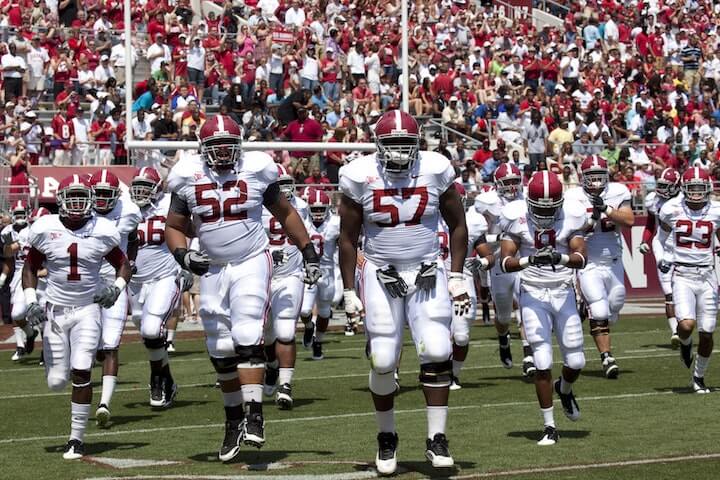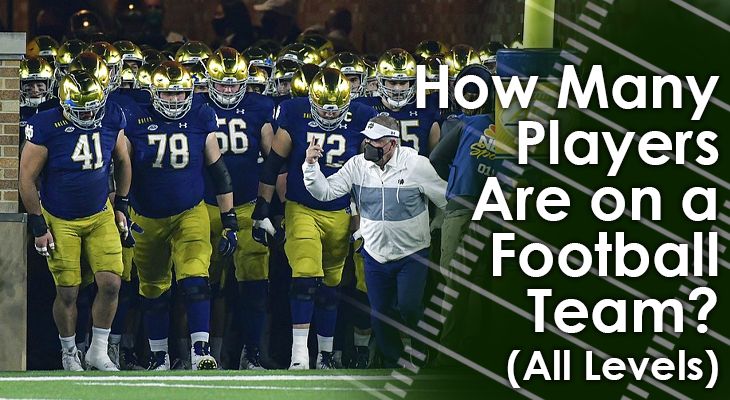No matter what level of football you're coaching, the basis of your team will be relatively the same -- in terms of the players who take the field for each play.
But, just like how the game itself changes dramatically from one level of football to the next, so too does the general makeup of a football team.
The professional level of football in America is the only one that places clear limits on how many players can be on a team.
Despite this, there are many differences in how a football team is constructed, and how many players there will be from one level to the next.
Let's take a look at the typical breakdown by level.
Players on the Field
First off, it's important to note that at each level of the game, there will be only 11 players per team on the field at a time.
Offense, defense, and special teams units all must adhere to the 11-player limit.
This limit applies regardless of level -- from the early stages of youth football to the highest level of the National Football League.
This means there should be a total of 22 players on the field at any given time -- 11 for each team.
How Many Players on a Youth Football Team?
The number of players on a youth football team isn't regulated or limited by any one governing body.
Some local leagues will place limits on the number of players that can be on a football team, but in a lot of cases it comes down to how many total players decide to sign up.
In some instances, football will be very popular in an area, with a lot of players trying out. In other cases, there won't be as many to choose from.
Coaches typically have the final decision as to how many players they want to carry on the team.
They will normally not have any "cuts" at youth football, though, as they want to allow all players who want to play a chance to learn the game.
Therefore a typical youth football team will have roughly 25 to 35 players on it.
This will allow all players to see the field in different situations, with players getting a taste for offense, defense and special teams.

How Many Players on a High School Football Team?
The next big step up in talent level is at high school.
There is a standard governing body for high school football called the National Federation of State High School Associations (NFHS).
This agency oversees high school football in 48 of the states in America.
The NFHS doesn't limit the total number of players that can be on a high school roster.
The only rule they have is that two players with the same number can't be on the field at the same time.
What this means is that the roster size is usually limited to 99 players, although it can technically grow to more.
Essentially, roster size at the high school level comes down to the same two factors as youth football.
The first being (1) how many players try out for the team, and the second is (2) coach's preference.
In most cases, high school teams will carry roughly 40 to 50 players on the team.
A larger roster size is needed as players begin to become more specialized, playing only offense or only defense, for example.
How Many Players on a College Football Team?
Another big jump in talent level comes at college football.
The NCAA regulates all sports at the college level in the U.S., including football.
They have many rules when it comes to the number of games played and how teams are constructed.
However, the NCAA doesn't place a particular limit on how many players can be on a football team.
Many college football teams, therefore, carry 100 or more players on their team.
This allows a lot of young players to learn the game, while also accounting for further specialization -- most players play only one position.
At the same time, the extra roster size serves as a backup for injuries and other unforeseen circumstances.
The only limit the NCAA places on college football teams is that only 85 players can be on a scholarship each year.
This goes for all teams at the FBS Division I level.
The number of allowed scholarships decreases for each subsequent division of college football.

How Many Players Are on an NFL Team?
The NFL has very strict rules when it comes to roster size and construction.
Every team is limited to 53 players on their active roster.
These players stay on the roster throughout the year, practicing and traveling with the team.
Come game day, the head coach is only allowed to "dress" 47 players for a game.
This means there are six players on the active roster who are not allowed to play in a game.
That number can increase to 48 players suiting up as long as the team suits up at least eight offensive linemen.
Beyond those 53 players on the active roster, each team can only carry 12 players on what's called the practice squad.
These players have a contract with the team and practice with the team during the week.
These players are not allowed to travel with the team for games, and they can't suit up in games, either.
They can, however, get promoted to the active roster at any point during the season.
These players help the team prepare for games and serve as backups in case of injury or other situations.
Conclusion
The game of football changes a lot from one skill level to the next, and that is evident with how many players are on a football team at each level.
The NFL places definitive limits on the number of players on a team, while the other levels typically do not.
The way teams construct their roster significantly varies from level to level based on interest in the game and the increased specialization of players.

